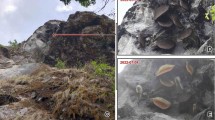Abstract
The biodiversity of honeybee (Apis mellifera) populations from Tenerife (Canary Islands, Spain) has been assessed by restriction analysis of a mitochondrial non-coding intergenic region. Seventy-nine colonies were analysed from thirteen apiaries in six populations that have been kept from recent queen introduction. The length and restriction pattern of the PCR amplified products of the intergenic region identified four mitochondrial haplotypes. One of these haplotypes shows the same restriction pattern and composition of the intergenic region carried by honeybees belonging to the African lineage. Two haplotypes are characterised by a particular intergenic region found with high frequency in the Canarian populations. The haplotype representative of the East European honeybee lineage shows a frequency of 35%, thus indicating introduction of queen honeybees. The finding of this haplotype in Canarian honeybees suggests that hybridisation between the endemic Apis mellifera populations and imported bees is occurring in Tenerife.
Similar content being viewed by others
References
Bar-Cohen R, Alpern G and Bar-Anan R (1978) Progeny testing and selecting Italian queen for brood area and honey production. Apidologie 9: 95–100
Cañas S (1998) Tenerife: apicultura bajo el volcán. Vida Apícola 88: 36–44
Crozier RH and Crozier YC (1993) The mitochondrial genome of the honeybee Apis mellifera: complete sequence and genome organization. Genetics 133: 97–117
De la RÚa P, Serrano J and Galián J (1998) Mitochondrial DNA variability in the Canary Island honeybees (Apis mellifera L.). Molecular Ecology 7: 1543–1548
De la RÚa P, Galián J and Serrano J (1999) Variabilidad del ADN mitocondrial en poblaciones de abejas de la miel (Apis mellifera L.) de la Región de Murcia. Investigación Agraria 9: 43–49
De la RÚa P, Simon UE, Tilde A, Mortiz RFA and Fuchs S (2000) MtDNA variation in Apis cerana populations from the Philippines. Heredity 84: 124–130
Franck P, Garnery L, Solignac M and Cornuet J-M (1998) The origin ofWest European subspecies of honeybees (Apis mellifera): new insights from microsatellite and mitochondrial data. Evolution 52: 1119–1134
Garnery L, Cornuet J-M and Solignac M (1992) Evolutionary history of the honey bee Apis mellifera inferred from mitochondrial DNA analysis. Molecular Ecology 1: 145–154
Garnery L, Solignac M, Celebrano G and Cornuet J-M (1993) A simple test using restricted PCR-amplified mitochondrial DNA to study the genetic structure of Apis mellifera L. Experientia 49: 1016–1021
Garnery L, Mosshine EH, Oldroyd BP and Cornuet J-M (1995) Mitochondrial DNA variation inMoroccan and Spanish honey bee populations. Molecular Ecology 4: 465–471
Garnery L, Franck P, Baudry E, Vautrin D, Cornuet J-M and Solignac M (1998) Genetic diversity of the west European honey bee (Apis mellifera mellifera and A. m. iberica). I. Mitochondrial DNA. Genetics, Selection Evolution 30: 31–47
Juan C, Emerson BC, Oromi P and Hewitt GM (2000) Colonization and diversification: towards a phylogeographic synthesis for the Canary Islands. Trends in Ecology and Evolution 15: 104–109
Kauhausen-Keller D and Keller R (1994) Morphometric control of pure race breeding in the honeybee (Apis mellifera L.). Apidologie 25: 133–143
Kunkel G (1976) Biogeography and ecology in the Canary Islands. Dr W Junk bv Publishers, The Hague
Meusel M and Moritz RFA (1990) Transfer of paternal mitochondrial DNA in fertilization of honeybee (Apis mellifera L.) eggs. In: Veeresh GK and Viramath CA (eds) Social Insects and the Environment, pp 135, Oxford, New Delhi
Moritz RFA, Cornuet J-M, Kryger P, Garnery L and Hepburn HR (1994) Mitochondrial DNA variability in South African honeybees (Apis mellifera L.). Apidologie 28: 169–178
Palmer MR, Smith DR and Kaftanoglu O (2000) Turkish honeybees: genetic variation and evidence for a fourth lineage of Apis mellifera mtDNA. Journal of Heredity 91: 42-46
Ruttner F, Tassencourt L and Louveaux J (1978) Biometrical-statistical analysis of the geographic variability of Apis mellifera L. Apidologie 9: 363–381
Sambrook J, Fritsch E and Maniatis T (1989) atMolecular cloning. A laboratory manual. Cold Spring Harbor Laboratory Press, New York
Schneider S, ueffer J-M, oessli D and xcofier L (1997) Arlequin: A software for population genetic data analysis. Ver 1.1. Genetics and Biometry Lab, Department of Anthropology, University of Geneva
Smith DR (1991a) African bees in the Americas: insights from biogeography and genetics. Trends in Ecology and Evolution 6: 17–21
Smith DR (1991b) Mitochondrial DNA and honey bee biogeography. In: Smith DR (ed) Diversity in the Genus Aps, pp 131–176. Boulder, Colorado
Smith DR and Hagen RH (1997) The biogeography of Apis cerana as revealed by mitochondrial DNA sequence data. Journal of the Kansas Entomology Society 69: 294–310
Walsh PS, Metzqer DA and Higuchi R (1991) Chelex 100 as a medium for simple extraction of DNA for PCR-based typing from forensic material. Biotechniques 10: 506–512
Woodward D (1993) Ligurian bees. American Bee Journal 133: 124–125
Author information
Authors and Affiliations
Rights and permissions
About this article
Cite this article
De La Rúa, P., Serrano, J. & Galián, J. Biodiversity of Apis mellifera populations from Tenerife (Canary Islands) and hybridisation with East European races. Biodiversity and Conservation 11, 59–67 (2002). https://doi.org/10.1023/A:1014066407307
Issue Date:
DOI: https://doi.org/10.1023/A:1014066407307




